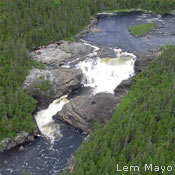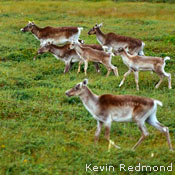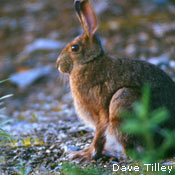A vast landscape of ponds, rivers, barrens, bogs and fens, forests, and thickets, the Bay du Nord Wilderness Reserve is one of the last major unspoiled areas remaining on the island of Newfoundland.
- How to get There
- Activities
- Maps
- Services
- Fees and Schedules
- Rules and Regulations
- Permits
- Other Resources
- Contact Information
Its 2,895 km2 of wilderness environment encompass:
- the largest protected river system in the province
- the Canadian Heritage River-nominated Bay du Nord River
- spectacular topographic features that include Mount Sylvester in the east, the Tolt in the west, and Smokey Falls on the Bay du Nord river
- much of the range of the 15,000-animal Middle Ridge caribou herd, which extends into the adjacent Middle Ridge Wildlife Reserve
- the largest Canada goose habitat in Newfoundland
The area is an excellent venue for canoeing or kayaking, wilderness camping, angling and hunting, bird and wildlife watching, and outdoor photography (entry permits required). It is also a popular snowmobiling destination though snowmobiling is not permitted in the caribou winter range from December 15 to March 15. See Bay du Nord Wilderness Reserve User’s Guide for a map of the winter range of the caribou herd.
The reserve is a wilderness-there are no facilities, amenities, trail markers, or public buildings within its borders. The climate has a strong maritime influence (particularly the southern section of the reserve), with relatively mild winters, cool summers, as well as fairly high rainfall and frequent fog. Farther north and more in the interior of the Island, winters are colder, snowfall is greater, and the summers are warmer.
Use the following guidelines when preparing for your visit:
- obtain an entry permit
- let someone know your route and expected time of return
- travel light and leave no trace of your passage
- carefully plan your clothing, footwear, and equipment
- take a compass and appropriate 1:50,000 topographic maps
- read and abide by the rules and regulations
Note that if you take a cell-phone, coverage will be spotty-though it is possible to make calls from some hilltops.
The main conservation objective for establishing the reserve was to protect enough habitat (primarily winter) to maintain the Middle Ridge woodland caribou herd, which is the largest herd on Island.
The reserve also protects a representative portion of the Maritime Barrens-Central Barrens subregion (986 KB).
The cultural history of the area includes Mi’kmaq presence in the 18th and 19th centuries. Geologist and archaeologist James Howley was the first European to travel the entire Bay du Nord River system (1887). The cairn he erected to assist in triangulating his position while surveying the area still stands on the summit of Mount Sylvester. Trans-Newfoundland explorer William Epp Cormack crossed southern part of reserve on his cross-island trek of 1822.
Created as a provisional reserve in 1986, the area has been officially designated as the Bay du Nord Wilderness Reserve since 1990.
How to get there
Located in the southeastern portion of central Newfoundland, the Bay du Nord Wilderness Reserve is flanked by three main highways. To its north is the Trans-Canada, to the west Route 360 (extending from Bishop’s Falls to Harbour Breton), and to the east Route 210 (the Burin Peninsula highway).
Entry permits are required to visit the reserve. Access to the reserve is by hiking, snowmobile, boat, or aircraft. No all-terrain vehicles are permitted in the reserve. Note that snowmobiling is not permitted in the caribou winter range from December 15 to March 15, and aircraft require a permit to land. See Bay du Nord Wilderness Reserve User’s Guide for a map of the winter range of the caribou herd.
Hikers can access the reserve from trails that run off Route 360: one is 12 km north of Jipujijkuei Kuespem Provincial Park and leads to the edge of the Middle Ridge Wildlife Reserve; the other is 4.5 km south of the park and leads to a transmission line that enters the reserve below Medonnegonik and Koskaecodde Lakes and continues along much of the southern boundary of the reserve. From the east, the best way in is from Piper’s Hole River. Here, hikers can follow a transmission line right-of-way which leaves near the river and tracks west along the southern boundary of the reserve. These trails and transmission lines are marked on the topographical maps of the area.
As described above, a transmission line leads west from the Piper’s Hole River to the Bay d’Espoir highway, following much of the reserve’s southern boundary. Newfoundland Hydro personnel use an access road from the Bay d’Espoir highway to reach the section of transmission line within the reserve. Motorized vehicle use of the portion of the transmission line trail in the reserve is restricted to Newfoundland Hydro personnel.
Canoeists can paddle into the reserve from Kepenkek Lake (near the reserve’s northern boundary). This lake is reached by a rough woods road from route 301 in Terra Nova National Park, or by air.
Float plane and helicopter access is possible, but you must have an entry permit. While over the reserve, aircraft must not be flown at altitudes lower than 600 metres, except during landing and take-off.
Activities
The Bay du Nord Wilderness Reserve is an excellent place for outdoor recreational activities including the following:
- Hiking
- Canoeing / Kayaking
- Wilderness Camping
- Bird and Wildlife Watching
- Nature Photography
- Hunting and Trapping
- Angling
Entry permits are required to visit the reserve for any of these activities.
Hiking
An outstanding wilderness hiking experience from Diamond Lake to Howley’s Cairn (the summit of Mount Sylvester, 378 metres above sea level) will give you a spectacular view of the area.
There are no developed hiking trails along the Bay du Nord, but old fishing trails along the river provide access to a number of the canoe routes.
As well, the areas around Smokey Falls and the abandoned community of Bay du Nord can both be explored on foot.
Canoeing / Kayaking
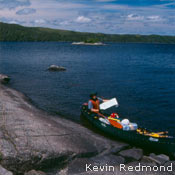
For expert canoeists and kayakers, the Bay du Nord river offers a diverse and challenging experience.
The most popular tour is a 100 km, five- to seven-day trip, beginning at Kepenkeck Lake. This tour takes you in a southward direction through several types of riverscapes, and ends at Pool’s Cove in Fortune Bay, on Newfoundland’s south coast. The divisions of the trip include:
- Kepenkeck Lake to the inflow of Kaegudeck Lake – approximately 26 km, passing through a chain of relatively small lakes.
- Kaegudeck Lake to Medonnegonix Lake – approximately 20 km through a group of large lakes, with several portages.
- Medonnegonix to Smokey Falls – 30 km of broken channel, with numerous rapids and waterfalls. This stretch and the next one are the most challenging section of the river.
- Smokey Falls to Bay du Nord village – approximately 17 km, a deeply incised channel with lengthy rapids and turbulent waters.
- Bay du Nord to the sea – from this abandoned village, the channel opens out to the magnificent vistas of Fortune Bay.
Many other canoe or kayak trips are possible in the reserve, including routes along the river systems of the Salmon, North East, and North West Rivers, as well as through abundant ponds. The North West River, for example, offers a less strenuous, two-day passage through birch glades and pine trees, with a 3-km finale of exciting, moderately difficult rapids (most of which are navigable).
Throughout the system, portages are generally short. When water levels are high (early spring), the lower Bay du Nord offers some Class IV or greater rapid sequences, and good kayaking opportunities.
Wilderness Camping
Potential wilderness campsites are spread throughout the river system there are more than a dozen between Smokey Falls and the mouth of the river, for example.
Camping in one location is restricted to no more than 10 days and an entry permit is required. Please do not litter, and pack out everything you bring in, including cans, glass, and other refuse. In some seasons, open fires are not permitted. Contact your local office of the Department of Natural Resources to determine if open fires are permitted.
Bird and Wildlife Watching
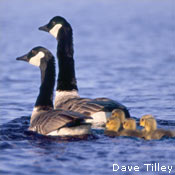
Binoculars are an excellent addition to the pack when travelling in the Bay du Nord Wilderness Reserve.
The southeastern corner of the reserve provides the largest area of Canada goose habitat on the Island of Newfoundland. Other species of birds include common loon, northern harrier, belted kingfisher, common snipe, and rough-legged hawk. You’ll also find willow ptarmigan.
The forested areas of the reserve are home to northern waterthrush and pine grosbeak. Elsewhere, keep an eye out for osprey, common terns, blue jays, owls and songbirds.
In addition to the large mammals-caribou, moose, and black bear-wildlife includes all the animals common to the Island: lynx, fox, snowshoe hare, beaver, muskrat, otter, mink, weasel, red squirrel, shrew, meadow vole, and brown bat.
At about 15,000 animals, the Middle Ridge caribou is the largest woodland caribou herd on the Island. Woodland caribou live on barrens and in coniferous forests. Adult females can weight up to 135 kg, males can reach 270 kg; both genders can have antlers.
The caribou eat the slow-growing lichens on the barrens during the winter and a variety of other green plants in the summer. The majority of the herd winters in the southeastern portion of the reserve, near Allens Pond and Otter Pond. The calving season begins in late May. Most migrate further south of the reserve, within viewing distance of the Tolt. Adult males and non-breeding caribou disperse throughout the range.
In the summer, the majority of the herd can be found more to the south-they seek the cool breezes of the coast.
Hunting and Trapping
It is possible to hunt large and small game in the reserve-commonly hunted species include caribou, moose, snowshoe hare, and ptarmigan (known locally as partridge).
Residents and non-residents of the province can participate in this activity if, in addition to an entry permit, they hold a valid hunting licence,-which are carried while in the reserve-abide by provincial and federal legislation, and only hunt species for which an open season has been declared. Note that the use of ATVs for game retrieval is not allowed in the reserve.
With an entry permit, licensed trappers can trap mammals in the reserve, including beaver, lynx, mink, muskrat, otter, red squirrel, fox, and weasel.
Note that snowmobiling is not permitted in the caribou winter range from December 15 to March 15. See Bay du Nord Wilderness Reserve User’s Guide for a map of the winter range of the caribou herd.
Angling
The Bay du Nord is a scheduled Atlantic salmon river. Smokey Falls marks the limit of freshwater habitat for the sea salmon; above the falls, landlocked Atlantic salmon fishing is good.
In addition to an entry permit, residents must have a valid salmon licence, available at many local sport shops and convenience stores.
In addition to an entry permit, non-residents of the province require a licence to fish in any inland waters; they also must be accompanied by a licensed guide when fishing for salmon in the reserve. For a list of licenced guides, visit the Government of Newfoundland and Labrador Hunting and Fishing Site.
Services
There are few services within the reserve so it is important to use these guidelines when preparing for your visit:
- Obtain an entry permit
- Let someone know your route and expected time of return
- Travel light and leave no trace of your passage
- Carefully plan your clothing, footwear, and equipment
- Take a compass and appropriate 1:50,000 topographic maps
- Read and abide by the rules and regulations
Note that if you take a cell-phone, coverage will be spotty-though it is possible to make calls from some hilltops.
Fees and Schedule
Permits are required for various activities, but no fees are charged.
The reserve is open all year round. However, certain activities will be greatly influenced by the season and weather conditions.
Note that snowmobiling is not permitted in the caribou winter range from December 15 to March 15. See the Bay du Nord Wilderness Reserve User’s Guide for a map of the winter range of the caribou herd.
Rules and Regulations
Wilderness conservation is one of the province’s reserve system’s primary goals, so there are rules governing activities within all of our wilderness and ecological reserves. Some rules are universal, some vary with each reserve.
All wilderness reserves are open to a range of low-impact recreational activities-entry permits are required.
The following activities are strictly prohibited in all wilderness and ecological reserves:
- Disturbing, destroying, or removing plants, animals, or fossils
- Introducing plants, animals, or anything else to the reserve landscape
- Forestry, mining (including exploration), hydro development, agriculture, new roads, tracks, or buildings
- Driving off-road vehicles including all-terrain vehicles (ATVs)
In the Bay du Nord Reserve, the following regulations also apply:
- Entry permit is required. You must carry your entry permit (and other applicable permits) with you while in the reserve.
- Camping in one location is restricted to a maximum of 10 days.
- You must pack out everything you bring in, including cans, glass, and other refuse.
- Snowmobiling is not permitted in the caribou winter range from December 15 to March 15.
- Use of ATVs for game retrieval is not allowed in the reserve.
- During some seasons, open fires may be prohibited. Contact your local office of the Department of Natural Resources to determine if open fires are permitted. Completely extinguish fires before leaving.
- Aircraft must fly above 600 metres, except during take-off and landing
- Dogs and horses are permitted, if they are kept under control at all times
Read the official reserve regulations:
- Wilderness Reserve Regulations
- Bay du Nord Wilderness Reserve Order
- Wilderness and Ecological Reserves Act
Other Resources
The following resources can help you learn more about Bay du Nord Wilderness Reserve and Canadian Heritage River.
- Bay du Nord Wilderness Reserve Management Plan
- Managing the Bay du Nord River as a Canadian Heritage River (3.8 MB)
- Maritime Barrens ecoregion-Central Barrens subregion (987 KB)
- Maritime Barrens ecoregion-Southcoast Barrens subregion (1 MB)
- Island of Newfoundland Ecoregions and Subregions (489 KB)
For more resources on Newfoundland and Labrador’s protected areas, please visit Publications and Maps.
Adobe® Acrobat® Reader software can be used for viewing PDF documents. Download Acrobat® Reader for free.

